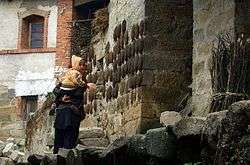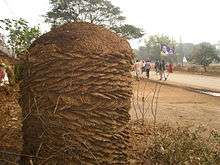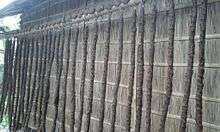Cow dung
Cow dung, also known as cow pats, cow pies or cow manure, is the waste product of bovine animal species. These species include domestic cattle ("cows"), bison ("buffalo"), yak, and water buffalo. Cow dung is the undigested residue of plant matter which has passed through the animal's gut. The resultant faecal matter is rich in minerals. Color ranges from greenish to blackish, often darkening soon after exposure to air.
.jpg)


Uses
Cow dung, which is usually a dark brown color, is often used as manure (agricultural fertilizer). If not recycled into the soil by species such as earthworms and dung beetles, cow dung can dry out and remain on the pasture, creating an area of grazing land which is unpalatable to livestock.
In many parts of the developing world, and in the past in mountain regions of Europe, caked and dried cow dung is used as fuel.
Dung may also be collected and used to produce biogas to generate electricity and heat. The gas is rich in methane and is used in rural areas of India and Pakistan and elsewhere to provide a renewable and stable (but unsustainable) source of electricity.[1]
In central Africa, Maasai villages have burned cow dung inside to repel mosquitos. In cold places, cow dung is used to line the walls of rustic houses as a cheap thermal insulator. Most of villagers in India spray fresh cow dung mixed with water in front of the houses to repel insects. It is also dried into cake like shapes and used as replacement for firewood.
In Rwanda, it is used in an art form called imigongo.

Cow dung is also an optional ingredient in the manufacture of adobe mud brick housing depending on the availability of materials at hand.[2]
A deposit of cow dung is referred to in American English as a "cow pie," or less commonly "cow chip," and in British English as a "cowpat".[3] When dry, it is used in the practice of "cow chip throwing" popularized in Beaver, Oklahoma in 1970.[4][5] On April 21, 2001 Robert Deevers of Elgin, Oklahoma, set the record for cow chip throwing with a distance of 185 feet 5 inches (56.52 m).[6]
Cow dung is also used in Hindu religious fire yajna as an important ingredient.[7]
Cow dung is also used in the making of panchgavya, for use in Hindu rituals. [8]
Ecology
Cow dung provides food for a wide range of animal and fungus species, which break it down and recycle it into the food chain and into the soil.
In areas where cattle (or other mammals with similar dung) are not native, there are often also no native species which can break down their dung, and this can lead to infestations of pests such as flies and parasitic worms. In Australia, dung beetles from elsewhere have been introduced to help recycle the cattle dung back into the soil. (see the Australian Dung Beetle Project and Dr. George Bornemissza).[9]
Cattle have a natural aversion to feeding around their own dung. This can lead to the formation of taller ungrazed patches of heavily fertilized sward. These habitat patches, termed "islets", can be beneficial for many grassland arthropods, including spiders (Araneae) and bugs (Hemiptera). They have an important function in maintaining biodiversity in heavily utilized pastures.[10]
Variants
A buffalo chip, also called a meadow muffin, is the name for a large, flat, dried piece of dung deposited by the American bison. Well dried buffalo chips were among the few things that could be collected and burned on the prairie and were used by the Plains Indians, settlers and pioneers, and homesteaders as a source of cooking heat and warmth.
Bison dung is sometimes referred to by the name nik-nik. This word is a borrowing from the Sioux language (which probably originally borrowed it from a northern source). In modern Sioux, nik-nik can refer to the feces of any bovine, including domestic cattle. It has also come to be used, especially in Lakota, to refer to lies or broken promises, analogously to the vulgar English term "bullshit" as a figure of speech.
See also
- Biomass briquettes
- Chicken manure
- Coprophilous fungi
- Dry animal dung fuel
- Imigongo
- Shit Museum
- Sigri (stove) stove fueled with dried cow dung
References
- "Cow dung – a energy". denmark.dk. Retrieved 14 February 2015.
- "Your Home Technical Manual - 3.4d Construction Systems - Mud Brick (Adobe)". Archived from the original on 2007-07-06.
- "Cowpat - Definition and More from the Free Merriam-Webster Dictionary". merriam-webster.com. Retrieved 14 February 2015.
- "Cow Chip Throwing Capital of the World". RoadsideAmerica.com. Retrieved 14 February 2015.
- Town of Beaver, Oklahoma Archived 2010-12-28 at the Wayback Machine
- RAYNOR, JESSICA. "Old chip-throw record is tossed - Amarillo.com - Amarillo Globe-News".
- "Holy Cow – Importance of Cow in Hinduism and Sacred Ayurvedic Texts – Sattvic Milk and Dairy Products".
- Jain, Rupam (2010-03-08). "Cow dung and urine 'healthy'". Telegraph. Retrieved 2019-11-13.
- Bornemissza, G. F. (1976), The Australian dung beetle project 1965-1975, Australian Meat Research Committee Review 30:1-30
- Dittrich, A. D. K. and Helden A. J. 2012. Experimental sward islets: the effect of dung and fertilisation on Hemiptera and Araneae. Insect Conservation and Diversity 5:46-56.
External links
| Wikimedia Commons has media related to Cattle feces. |